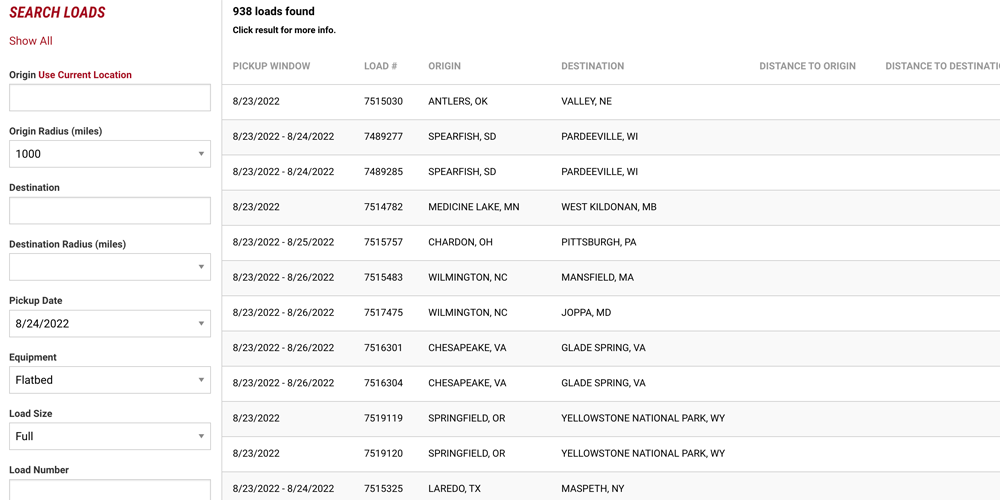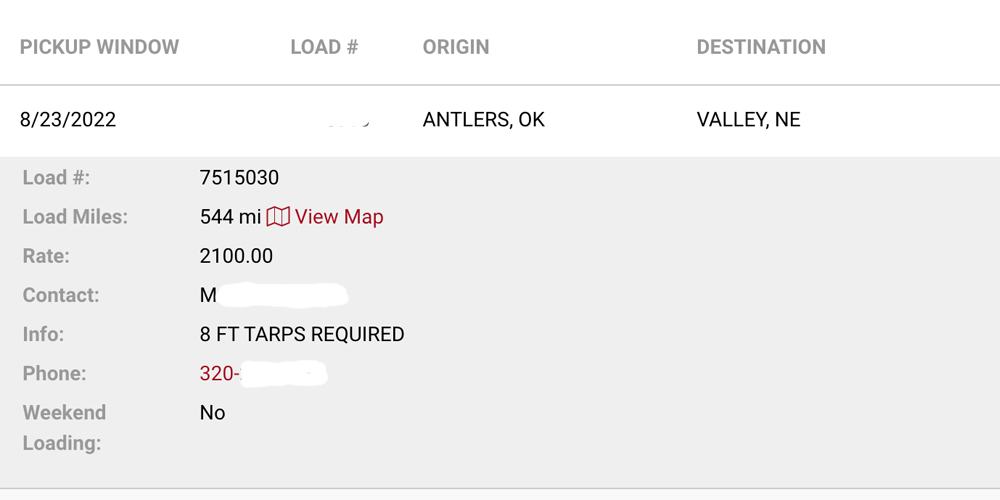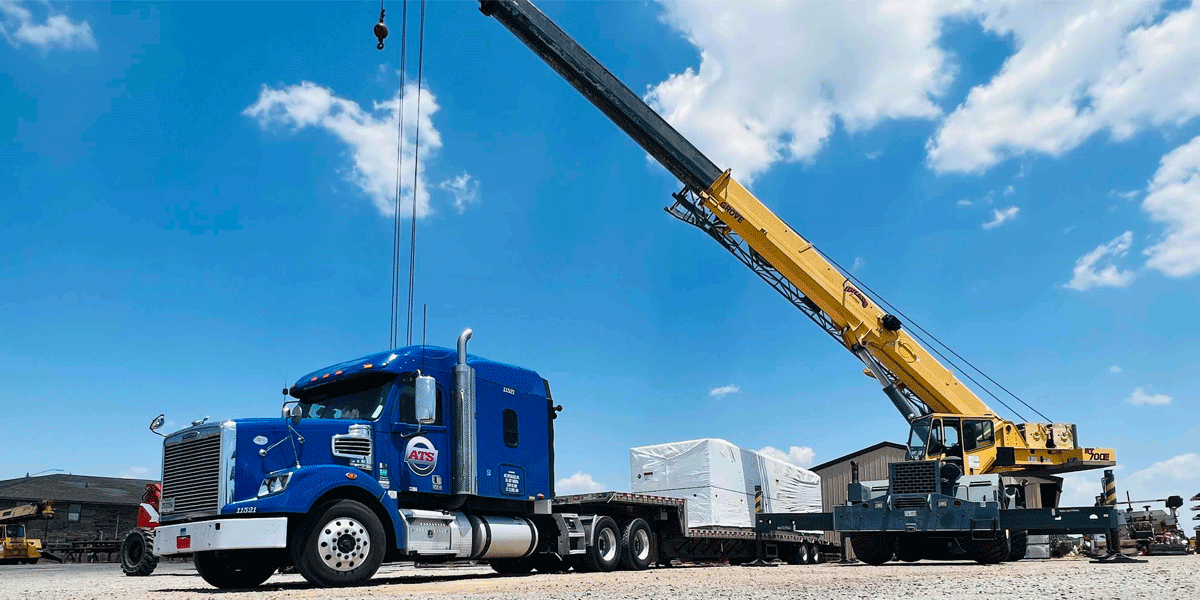Internal vs. External Load Boards: Everything You Need to Know
Aaron has been with ATS since 2014. He began in fleet operations support. He worked with his own fleet of drivers while also dispatching wind turbine blade drivers. Aaron spent a couple years in the planning department working with both contractors and company drivers. He has been in the operations manager role since 2019.
Do you understand the difference between an internal and an external load board?
Many drivers misunderstand the differences between the two even though they’re different and have different requirements.
When you use an internal load board, generally speaking rates are already negotiated and details are already finalized. On an external load board, drivers can negotiate their rates, bid on loads and arrange pickup and drop-off details. External load boards, therefore, require a lot more work for drivers but they offer the freedom drivers crave. Using them properly has also been historically proven to be extremely profitable for drivers.
Typically, owner-operators signed on with a company use an internal load board. External load boards are used by true owner-operators who operate under their own authority.
If you’re only accustomed to hauling freight with an internal load board, you might be in for a rude awakening if you decide to start hauling freight on an external load board. A lot of drivers end up in hot water because they thought they understood what it took to haul freight on an external load board, but they weren’t ready for it.
We don’t want you to make that mistake. Here at Anderson Trucking Service (ATS), we want to ensure your success no matter who you’re hauling freight with.
In this article, we’ll not only explain the differences between internal and external load boards along with their pros and cons, but we’ll also help you think big picture and decide what type of owner-operator you'd like to be.

What is an Internal Load Board?
An internal load board, also called an in-house load board, is a freight board that a trucking company utilizes with its customer freight. Only drivers that work for or with that company can use the load board.
An internal load board is confined to the company’s range of customers. The freight offered on an internal load board is based on contracts customers have signed for one to three years. Therefore the freight has already been picked and priced for the drivers under the company’s umbrella to haul (company drivers and independent contractors). Rates are already negotiated and details, like pickup and drop-off times, are already put in place.
Every company runs its load board a bit differently. In some cases, the freight offered on an internal load board is the freight that the company doesn’t have the capacity to haul, so they offer it up to owner-operators. In some cases, all the freight they have to haul is placed up for grabs on the internal load board and anything that isn’t chosen is given to company drivers.
What is an External Load Board?
An external load board is a board with brokered freight that all owner-operators can access.
External load boards usually offer spot market freight, which means drivers can name their price and their requirements before they agree to haul each load. They can bid on loads and negotiate details, like pickup and drop-off times.
There are dozens of external load boards that you can use. They’re typically designed by a trucking company and the freight offered is the freight they can get customers to place on there.
Pros and Cons of Internal Load Boards
It’s important to understand both the pros and cons of internal load boards before deciding to use one.
Pro: You Can Count Stable Freight Rates
Because the freight on internal load boards is asset-owned, it’s associated with a customer contract. This offers stable freight rates because the contracts are signed for one to three years. Even if the market drastically changes, you can count on rates to be fairly stable on an internal load board because the rates are based on an agreed-upon rate.
Pro: You Don’t Have to Worry About Billing or Getting Paid
The rates are already agreed upon on an internal load board. Because you’re still working with a company, not the customer directly, your trucking company is in charge of paying you. In some cases, you can get paid the next day after you finish hauling a load.
Rates are already set, so you also don’t have to worry about doing any sort of billing or negotiating price.
Pro: You Can Count on Company Support
When you run on internal load boards, you’ll still have the stability of the company to support you. You’re protected by that company. While you’ll still be considered an owner-operator, they can help you.
Con: Freight Variety is Limited
When you utilize an internal load board, you’re limited to the freight the company can get contracts for and the lanes they’ve chosen. If the company doesn’t have the freight that you like to haul, you’re out of luck.
Maybe you want to haul cars but they don’t offer that. Contrastingly, maybe they only haul hazmat freight and you don’t want to haul that either. They either might not go to the areas you want to haul in or not offer the exciting, over-dimensional loads that you want to haul. That can be frustrating.
Additionally, some companies hold back freight from the load board, so you might not get the best freight available from that company. The company may protect certain customers and only allow company or lease drivers to haul that freight.
Con: Rates Won’t Adjust As Fast as they Do in the Spot Market
While the spot market can be volatile and the rates certainly aren’t stable like they are with contracted customer freight, that’s not always a good thing. If the spot market is great and rates are high, you won’t reap the rewards on internal load boards.
It can take a while for contracted rates to adjust as quickly as the market adjusts. Contracts need to be readjusted, and that’s not always a quick process. Sometimes, you might not feel like you’re making as much money as you could be.
Con: You Won’t Build a Customer Relationship
Tenure doesn’t really matter when you’re hauling freight on an internal load board. Because rates are already negotiated and you’re never directly corresponding with that customer, you never have the chance to build up a relationship with them. You could haul freight utilizing a certain freight lane weekly and do a great job, but they may randomly change the lane.
That doesn’t usually happen with an external load board because you have visibility with the customer. If you regularly haul for them, you don’t often lose the freight due to the customer changing the lane.

Pros and Cons of External Load Boards
Let’s see how the pros and cons of external load boards compare to internal load boards.
Pro: You’ll Have Plenty of Freight Variety
You have the freedom to haul anything you want with an external load board (anything that you’re legally allowed to haul with the proper permits, endorsements and equipment, that is). If one load board doesn’t have the freight you want to haul, you can hop onto another one.
One day you could be hauling lumber, the next day you could be hauling an airplane engine. One day you might have to tarp a load, the next day you could decide you’re never hauling a tarped load again.
You also have the freedom to choose whichever parts of the country you do (or don’t) want to haul freight in and out of.
This can make for an exciting path where every day is different.
Pro: When Rates are Good, You’ll Reap the Benefits
When the spot market is good, you can make great money using external load boards. Choose the freight you want to haul at the rate you’re willing to haul it and reap the rewards.
You’ll also have the opportunity to bid on freight and negotiate your rate, which gives you more control over your income. Many drivers make unbelievable money doing this.
Pro: Enjoy the Freedom You Want
Hauling freight on external load boards gives you the ultimate freedom. You can go where you want, haul the freight you want and hop from board to board.
You really get the opportunity to carve out your path.
Not only that, but you won’t have to answer to anyone other than yourself. You get to be your own boss.
Con: Spot Market Rates Can Take a Hit
While the spot market rates can be a pro, they can also be a con. The market can fluctuate wildly. One month the rates could be great and the next they could take a hit. You can struggle to find loads that pay as well as you’re accustomed to. It may require some extra work.
At the time of this writing, rates are down considerably compared to this time last year.
Con: You Might Not Get Paid Right Away
The timeliness of your pay can be an issue when you utilize external load boards. If you book loads independently and negotiate rates, you can be stuck with that customer’s payment terms. Some terms may be as high as 90 days, whereas you can get paid for loads in under a week when you haul freight on internal load boards.
You can be chasing down payments if you take a load from a bad broker. In some cases, you might not even get paid.
Keep in mind that this is not always the case with external load boards. Some customers may pay quickly.

Con: It Takes a Lot of Work
The freedom that external loads boards provide you might sound great, but it can also be overwhelming if you aren’t ready for it. Not only do you need to be very good at understanding your cost-per-mile and choosing your loads accordingly to ensure you make a profit, but you also have to do all the work of negotiating rates and payments.
If you just want to book a load and go, this might not be the best option for you. You’ll have a lot more work to do after you finish hauling that load. If paperwork and billing aren’t your strong suit and you have no desire to do it, external load boards probably aren’t for you.
How to Choose: Internal Load Boards vs External Load Boards
When deciding which one is right for you, it really comes down to what type of owner-operator you’d like to be. Whether you want to run with a company or run under your own authority, you’ll still get to select your own freight, but the freight choices and rates will vary (sometimes significantly) depending on which type of owner-operator you are.
Do you want to sign on with a company to haul their freight? Then you’ll use an internal load board.
Or, do you want to run under your own authority and haul whatever freight you want using external load boards?
If you sign on to haul freight for a company, consider some companies that utilize an internal load board will only allow you to select freight from their internal load board, while some companies do a hybrid method and will require you to use an external load board on the backhaul. Before you sign on with a company, figure out what they’re offering.
If you want to be a true owner-operator, you can haul freight from whatever external load board you wish to.
Before you make your decision, make sure you understand the clear differences between each type of owner-operator and what it takes to succeed down either path. The freedom to run under your own authority and use external load boards might sound great, but you have to consider how much freedom you’re ready for.
You might not be ready to handle the financial responsibility of owning your own truck, taking care of the paperwork, doing all the billing, keeping up with the market and planning out your loads weeks in advance to ensure you make a profit.
If you’ve only ever been a company driver or a lease driver, strongly consider taking smaller steps. You can do this by starting out on internal load boards as an owner-operator signed on with a company rather than taking on operating under your own authority.
Making the Move to be an Owner-Operator
Making the decision to be an owner-operator should be one of the slowest decisions you make. Review these articles before you take the next step.
- Types of Truck Owner-Operators [And How to Choose the Best Path]
- Should I Be an Owner-Operator? 4 Things You Must Consider First
- How to Successfully Choose Freight Using Load Boards [5 Tips]
If you already own your truck and you’re ready to take the next step but you’re not quite sure if you want to operate under your authority, consider hauling freight for ATS under our authority.
We’ll provide you with the support you need and you’ll still have the freedom to operate on your terms.
To learn more about the program or to see if you qualify, talk to a driver consultant.


